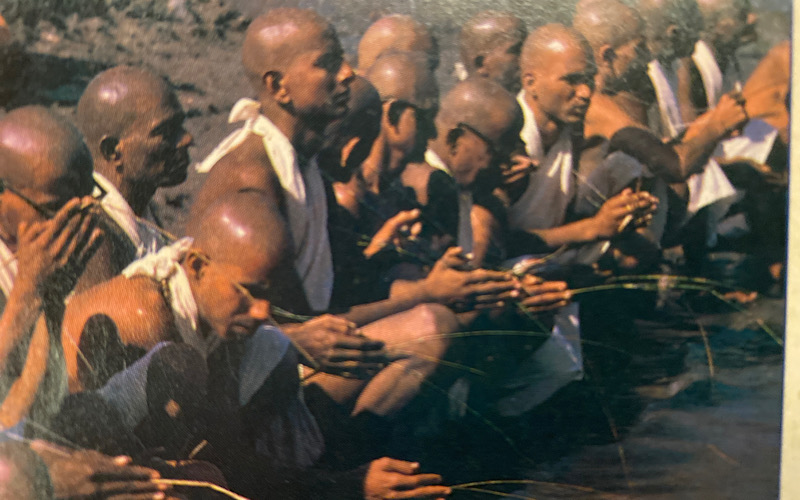By the Editor
When it comes to making choices for life, most cultures offer a profusion of one: marriage. Throughout the contemporary world, young men and women are guided, formally as well as subtly, intellectually as well as emotionally, toward family life. It’s never a matter of whether one will marry, but whom and when. The sooner the better. True, there are rare exceptions. In Tibet it is still considered noble for a son to take the Buddha’s vows and enter the monastery, and in some Western nations the Roman Catholic Church still encourages priests and nuns, though the laity is not cooperating.
It is commonly and rightly understood in Hinduism that there are two paths one may follow. Though they are complete opposites, both are noble and vouchsafed in the Vedas. Both challenge the soul to grow inwardly. The first is the path of the grihastha, or householder, the way of marriage and family, the route toward perfection of our skills, our intellect, our relationships. The second is the path of the sannyasin, of renunciation and the yogas, the passage toward soulful perfection through disciplines and ego-obliterating sacrifice.
While these two define most of the Hindu landscape, they are not the whole of it. There is another path, little spoken of but equally potent. It is a kind of in-between path, neither fully of family nor wholly of yoga. It is called the path of the sadhaka or brahmachari. It is, in Hindu culture, the way of the unmarried devotee who, whether woman or man, wears white and abjures the family dharma while not necessarily joining an ashram or following any monastic regimen.
Of course, it is not what they wear that gives the sadhaka (sadhika is the feminine form) his or her identity–though culturally the white dress quietly informs young men and women that this person is not available. It is their dedication to others and to their spiritual path that sets them apart. Sadhakas have a remarkable capacity, the direct result of their decision to raise consciousness instead of children. All the time that is normally consumed with getting things, with a career, with family attentions and social relationships goes into their work instead. So they are strikingly focused and effective people whose accomplishments in life can be awesome. Amazingly, there is little known of these single and singularly dedicated souls.
Sadhakas live “in the world but not of it.” Their service options are without limits, and their impact on Hinduism is immense. They may run a small school or healing center, or not. They may engage in some cultural work or ecological cause, or even run a business. Whatever they do, these men and women have been Hinduism’s least explored asset. Few know, it seems to me, the raging power of this third stream. We see it most evidently in the lives of souls like the US-based healer Maya Tiwari. Less obvious are those who serve selflessly and strive diligently beyond the public’s view.
Take for example the life of Krishna Kumar. He’s the perfect mate for any Indian woman–six-feet-three, handsome, fortyish, highly-educated and not the least bit impoverished. But Krishna Kumar intends never to marry. He has given his life to helping and healing, and now runs India’s second largest ayurveda clinic from Coimbatore in the South, exporting ancient healing remedies throughout the world. He travels widely, and freely, unfettered by family, able to respond to any need from any source at any time. He supports spiritual endeavors, and collaborates with a sadhika who enjoys the most articulate stage presence I have ever witnessed. For both of them, the wider world is family. They have no desire for wife or husband, no wish for children. They were born, they say, for another task, one that marriage would conflict with. They choose to be celibate and to serve. Their dedicated and selfless lives have impacted hundreds of thousands of people, uplifted and inspired even more.
Or take Keshav Hedgewar, founder of the RSS, who took a vow in 1910 at age 20 never to marry, but to lend his energies wholly to raising Hindu pride and consciousness. His life was instrumental to India’s independence and a testimony to the effectiveness of single-minded commitment, as was that of his successor, Golwalkar, who embraced as his mission the leadership of the RSS from 1940-1973. The next leader, Balasaheb Deoras, was also a life-long brahmachari, as is the current sarsanghchalak, Prof. Rajendra Singh. Under these four unmarried men, the institution grew from six teenagers in 1925 to nearly 700,000 active members. Even more remarkably, of the 6,000 or so pancharaks (a strategic local position in the group), well over 5,500 are sadhakas, bachelors dedicated solely to the RSS. I asked one retired RSS leader how much difference it makes if a member is unmarried or not. He said, “All the difference in the world. We tell our candidates, if you become married you can do 2 or 3 hours of service a day, at the most. So one unmarried pancharak is worth four or five ordinary men.” Thus, one of India’s largest and most influential institutions is living testimony to the power of the sadhaka path.
The Vivekananda Kendra in Kanya Kumari depends, almost exclusively, on sadhakas to carry out their extensive service and educational programs. But there is a change taking place in such groups, including the Kendra. Whereas traditionally the sadhaka’s decision is for life, nowadays young men and women are following the celibate path for 3 to 5 years, then opting to marry. Maybe that’s the Kali Yuga. Time will tell how this new approach works.
